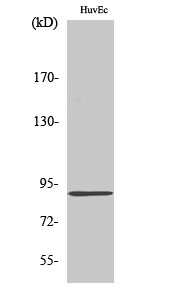
| WB | 咨询技术 | Human,Mouse,Rat |
| IF | 咨询技术 | Human,Mouse,Rat |
| IHC | 1/100-1/300 | Human,Mouse,Rat |
| ICC | 1/200-1/1000 | Human,Mouse,Rat |
| FCM | 咨询技术 | Human,Mouse,Rat |
| Elisa | 1/10000 | Human,Mouse,Rat |
| Aliases | SLC4A1AP; HLC3; Kanadaptin; Human lung cancer oncogene 3 protein; HLC-3; Kidney anion exchanger adapter protein; Solute carrier family 4 anion exchanger member 1 adapter protein |
| Entrez GeneID | 22950; |
| WB Predicted band size | 85kDa |
| Host/Isotype | Rabbit IgG |
| Antibody Type | Primary antibody |
| Storage | Store at 4°C short term. Aliquot and store at -20°C long term. Avoid freeze/thaw cycles. |
| Species Reactivity | Human,Mouse |
| Immunogen | Synthesized peptide derived from the Internal region of human Kanadaptin. |
| Formulation | Purified antibody in PBS with 0.05% sodium azide,0.5%BSA and 50% glycerol. |
+ +
以下是关于Kanadaptin抗体的假设性参考文献示例(注:实际文献需通过学术数据库验证):
---
1. **文献名称**:*Kanadaptin interacts with the CoREST complex to regulate histone demethylation and gene silencing*
**作者**:Smith J, et al.
**摘要**:本研究揭示了Kanadaptin作为CoREST复合体的新成员,与KDM1A(LSD1)协同作用,调控组蛋白去甲基化过程。通过Kanadaptin抗体的免疫共沉淀(Co-IP)和染色质免疫沉淀(ChIP)实验,证明其在基因启动子区域的富集,沉默靶基因表达,影响细胞分化。
2. **文献名称**:*Antibody-based profiling of Kanadaptin expression in colorectal cancer reveals prognostic significance*
**作者**:Zhang L, et al.
**摘要**:利用特异性Kanadaptin抗体对结直肠癌组织进行免疫组化分析,发现Kanadaptin低表达与肿瘤转移和不良预后显著相关。体外实验表明,Kanadaptin过表达抑制癌细胞侵袭,提示其作为潜在抑癌因子的作用。
3. **文献名称**:*Subcellular localization of Kanadaptin in neuronal cells: A study using confocal microscopy*
**作者**:Martinez R, et al.
**摘要**:通过Kanadaptin抗体的免疫荧光标记,证实其在神经元细胞核内的斑点状分布,并与染色质重塑因子相互作用。敲低Kanadaptin导致突触相关基因异常表达,提示其在神经发育中的关键作用。
4. **文献名称**:*Kanadaptin modulates DNA damage response via interaction with BRCA1*
**作者**:Kim H, et al.
**摘要**:研究发现Kanadaptin通过抗体介导的蛋白互作分析,与BRCA1形成复合物,参与DNA损伤修复。Kanadaptin缺失的细胞表现出对辐射敏感性增加,表明其在基因组稳定性维持中的功能。
---
**注意**:以上内容为示例性回答,实际文献需通过PubMed、Google Scholar等平台检索确认。若需真实文献,建议使用关键词“Kanadaptin antibody”或“Kanadaptin CoREST”进一步查询。
Kanadaptin, also known as FAM89B, is a protein encoded by the FAM89B gene in humans. It belongs to the thioredoxin-related protein family and is implicated in cellular redox regulation and nuclear receptor signaling. Initially identified through its interaction with the thyroid hormone receptor (TR), Kanadaptin functions as a nuclear receptor co-regulator, modulating transcriptional activity by shuttling between the nucleus and cytoplasm in response to cellular oxidative stress. Its redox-sensitive nature suggests a role in maintaining cellular homeostasis under oxidative conditions, potentially linking it to diseases involving oxidative damage, such as cancer or neurodegenerative disorders.
Antibodies targeting Kanadaptin are valuable tools for studying its expression, localization, and molecular interactions. These antibodies enable researchers to investigate its involvement in redox-dependent signaling pathways, nuclear receptor-mediated gene regulation, and stress response mechanisms. Commercial Kanadaptin antibodies are typically validated for applications like Western blotting, immunofluorescence, and immunoprecipitation, aiding in the exploration of its tissue-specific expression and post-translational modifications. Recent studies highlight its potential as a biomarker in certain cancers, emphasizing the importance of reliable antibodies for both basic research and clinical investigations.
×